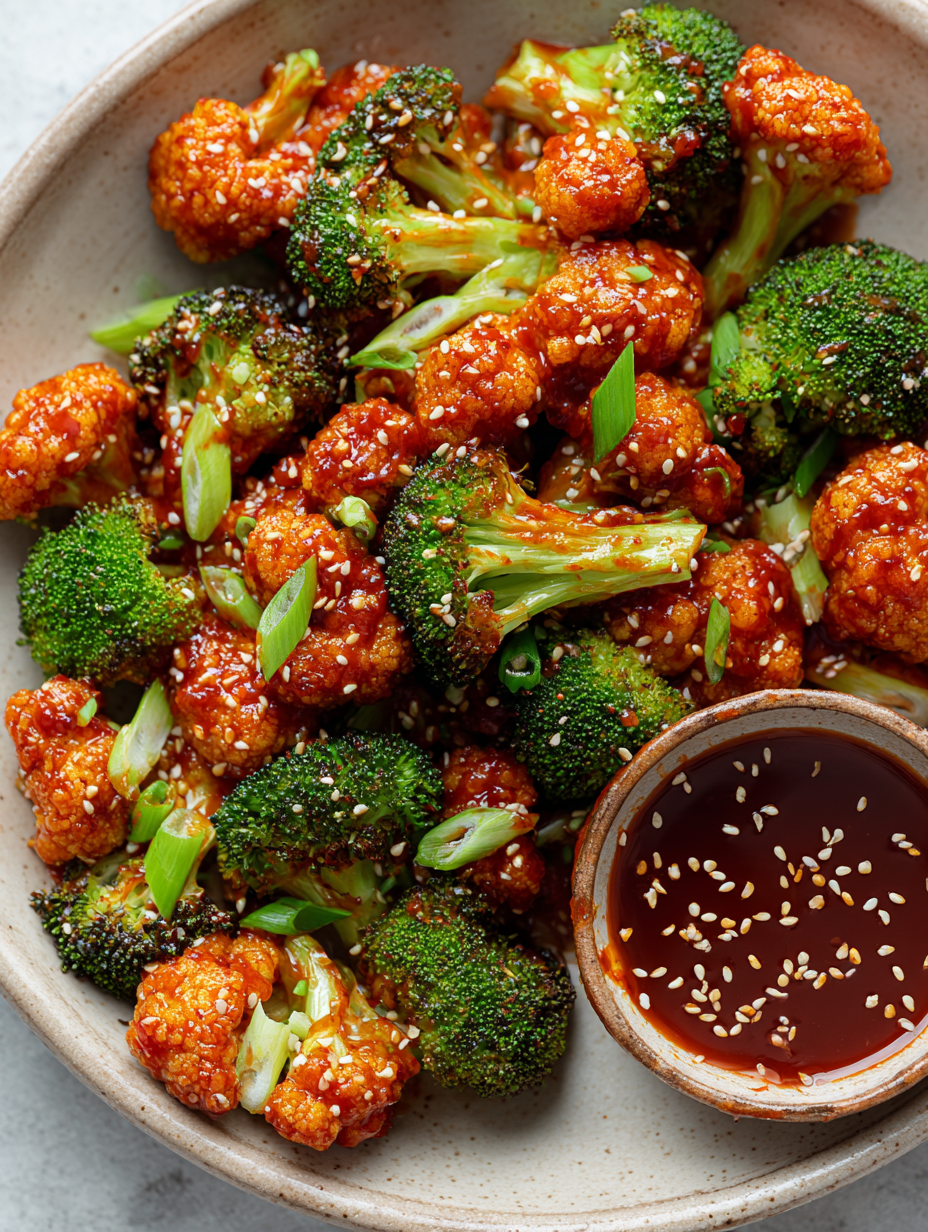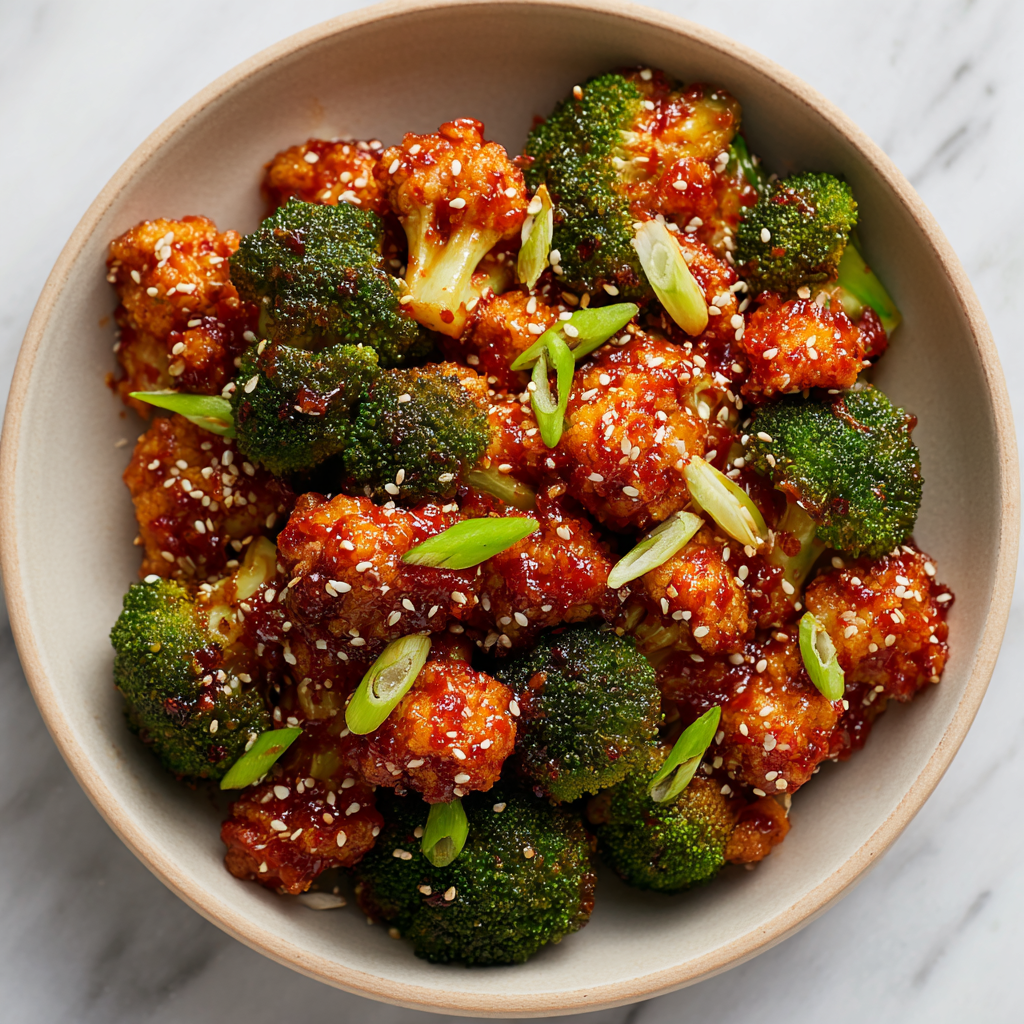 Save Pin
Save Pin
This bold and spicy Easy Gochujang Broccoli recipe transforms everyday broccoli into an irresistible Korean-inspired side dish. The tender roasted florets are coated in a tangy and umami-rich gochujang glaze that adds complex flavor in under 25 minutes. It’s a vibrant addition to any meal and perfect when you want something quick and exciting for your vegetables.
I first made this during a busy weeknight and loved how it added excitement to dinner without much effort. Now it’s a regular in my rotation for a tasty vegetable side that doesn’t feel boring.
Ingredients
- Broccoli: fresh and crisp, about one large head or four cups of florets is ideal for roasting evenly
- Olive oil or sesame oil: to coat the broccoli, choose extra virgin olive oil for a mild flavor or toasted sesame oil for a nutty twist
- Salt and black pepper: simple seasonings to enhance and balance the vegetables
- Gochujang: Korean fermented chili paste brings the signature spicy, sweet, and umami punch, look for a quality brand with good fermentation for best depth
- Soy sauce or tamari: adds saltiness and savory flavor, tamari is great if you want gluten-free
- Rice vinegar: gives acidity and brightness to balance the richness of the sauce
- Maple syrup or honey: introduces subtle sweetness to round out the spicy glaze
- Sesame oil: a small amount for toasted nutty aroma that ties the sauce together
- Garlic clove and fresh grated ginger: add pungent fresh aromatics for an extra layer of flavor
- Water: helps thin the sauce to perfect consistency so it sticks nicely to the broccoli
- Optional garnishes: include toasted sesame seeds, chopped green onions, crushed peanuts or cashews, and a squeeze of lime or lemon to brighten the final dish
Step-by-Step Instructions
- Prep and Roast the Broccoli:
- Preheat your oven to 425 degrees Fahrenheit which creates the ideal high heat for crispy edges. Toss the broccoli florets generously with olive or sesame oil along with salt and pepper to season evenly. Spread the broccoli in a single layer on a baking sheet; lining it with parchment paper makes cleanup easier. Roast for 15 to 18 minutes flipping the florets halfway through so they brown on all sides; look for tender stems and golden crispy edges as a sign of readiness.
- Make the Gochujang Sauce:
- In a small bowl or saucepan whisk together gochujang, soy sauce or tamari, rice vinegar, maple syrup, sesame oil, grated garlic, and ginger until well combined. Add one or two tablespoons of water gradually to thin the sauce to a consistency that will coat the broccoli without dripping too much. Warm the sauce gently over low heat on the stovetop or microwave for a half minute to marry the flavors and help it cling better to the broccoli; this step is optional but highly recommended.
- Toss and Serve:
- Transfer the roasted broccoli to a mixing bowl while still warm. Drizzle your homemade gochujang sauce over the broccoli and toss to coat every floret thoroughly so every bite bursts with flavor. Top with your choice of garnishes such as toasted sesame seeds, sliced green onions, crushed nuts, or a squeeze of fresh lime juice. Serve immediately as a side dish or pack it up for a flavorful addition to meal prep bowls.
 Save Pin
Save Pin
My favorite part of this dish is the gochujang paste, which adds a uniquely spicy and savory flavor unlike any other chili sauce I’ve used. I remember the first time I introduced this to my family, the excitement around trying something new made it a moment to savor. Since then, it has become a beloved staple in the house.
Storage Tips
Store leftovers in an airtight container in the refrigerator where they keep well for up to four days. For best texture, reheat in the oven at moderate heat so the broccoli regains some crispiness or warm gently on the stovetop rather than microwaving. This helps maintain the integrity of the sauce and fresh flavor.
Ingredient Substitutions
If you do not have gochujang, you can try mixing a blend of chili paste with a touch of miso paste and a pinch of sugar to mimic the sweet umami depth. For oil-free roasting, use a non-stick baking sheet lined with parchment paper but expect less crispy edges. Maple syrup can be swapped for agave or brown sugar depending on your pantry.
Serving Suggestions
This broccoli pairs wonderfully with steamed jasmine rice or as part of a bibimbap style bowl including other veggies and a fried egg. It is excellent as a topping for warm ramen or chilled noodle salads, lending a spicy kick. It also works brilliantly alongside grilled chicken, salmon, or tofu or tucked into lettuce wraps with cucumber and rice.
Cultural and Historical Context
Gochujang paste is a cornerstone of Korean cuisine with a history going back centuries as a fermented condiment made from chili powder, glutinous rice, fermented soybeans, and salt. Its distinctive flavor of heat balanced by sweetness and fermentation makes it a versatile ingredient in traditional and modern dishes alike. Roasting vegetables and tossing them with sauces like gochujang is a common practice in Korean cooking to add layers of texture and flavor.
Pro Tips
Always roast broccoli at high heat to get that addictively crispy edge and depth of flavor. Do not overcrowd the baking sheet or the broccoli will steam instead of roast, losing the desirable crunch. Warm the sauce slightly before tossing as it helps it to stick better and intensifies the flavor meld.
Commonly Asked Questions
- → What is gochujang?
Gochujang is a Korean fermented chili paste that combines spicy, sweet, and savory notes, adding rich umami and depth to dishes.
- → Can frozen broccoli be used?
Yes, thaw and pat dry frozen broccoli before roasting to ensure a crispy texture and even cooking.
- → Is oil necessary for roasting?
Oil helps achieve crispy edges when roasting. Without it, broccoli may roast softer; using parchment paper can prevent sticking.
- → How can this be made gluten-free?
Swap regular soy sauce for tamari or a certified gluten-free soy sauce to keep the dish free from gluten.
- → How do I adjust the spice level?
Modify the amount of gochujang sauce to control heat—use less for milder flavor, or add more for extra spice.
- → Can the sauce be prepared ahead?
Yes, the gochujang sauce can be whisked together in advance and warmed gently before tossing with roasted broccoli.
